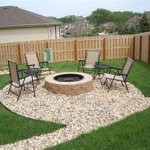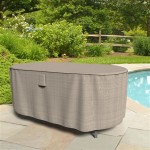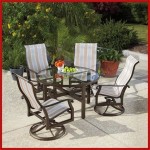Designing The Perfect Patio Furniture Layout Planner
Creating an inviting and functional outdoor living space requires careful planning, and a patio furniture layout planner serves as a crucial tool in achieving this goal. Thoughtful design considers the area's dimensions, anticipated usage, traffic flow, and aesthetic preferences. Without a strategic approach, a patio can easily become cluttered, uncomfortable, and underutilized. The following provides a comprehensive overview of the essential aspects involved in designing an effective patio furniture layout using a planning process.
Assess the Patio Space
The initial step involves a thorough assessment of the patio area itself. This means measuring the overall dimensions of the space, including length, width, and any unusual angles or curves. Accurate measurements are vital for determining the amount of furniture that can comfortably fit without overcrowding. Consider existing architectural features such as doors, windows, and walls, as these will influence furniture placement and traffic patterns. Additionally, note the location of any electrical outlets, water sources, or gas lines, as these may be needed for lighting, water features, or outdoor cooking appliances. Documenting these existing features provides a solid foundation for the subsequent planning stages. Consider the sun exposure throughout the day and the prevailing wind direction. Areas that receive intense afternoon sun might benefit from shade solutions such as umbrellas, pergolas, or awnings. Similarly, a patio exposed to strong winds may require heavier furniture or windbreaks to prevent items from being blown around.
Another key element of assessment involves evaluating the patio's surface material. Concrete, flagstone, wood decking, or composite materials each have unique characteristics that influence furniture selection and placement. For example, delicate furniture legs may sink into soft wood decking, whereas heavier pieces might be more suitable for a concrete surface. Understanding the surface material allows for informed decisions about furniture style and protective measures, such as furniture pads or mats. Consider the views from the patio. What is the primary focal point? Is it a garden, a swimming pool, or a scenic vista? Positioning furniture to maximize these views will enhance the overall enjoyment of the space. Conversely, identify any undesirable views, such as a neighbor's unsightly shed or a busy street, and consider using landscaping or screens to minimize their impact.
Finally, it is important to assess the surrounding environment. Take note of the adjacent landscaping, including trees, shrubs, and flowerbeds. These elements can contribute to the overall ambiance of the patio, but they can also pose challenges. For example, overhanging tree branches may drop leaves or sap onto the furniture, requiring regular cleaning. Similarly, dense shrubs may attract insects or impede airflow. Consider the potential impact of these environmental factors when selecting furniture and planning the layout.
Define the Patio's Purpose and Function
Defining the purpose and function of the patio is crucial for determining the types of furniture needed and how they should be arranged. Will the patio primarily be used for dining, lounging, entertaining, or a combination of these activities? Each purpose requires different types of furniture and a distinct layout to maximize functionality. A patio designed for dining, for example, will necessitate a dining table and chairs, whereas a lounging area will require comfortable seating such as sofas, armchairs, and ottomans. Consider the number of people that will typically use the patio at any given time. A small patio intended for a couple may only require two chairs and a small table, while a larger patio designed for entertaining might need seating for eight or more people. Answering these questions will guide the selection of furniture pieces and ensure that the layout accommodates the intended use.
Consider zoning the patio into distinct areas for different activities. For example, a portion of the patio could be dedicated to dining, another to lounging, and yet another to outdoor cooking. This zoning can be achieved through the strategic placement of furniture, rugs, and landscaping elements. Separating these areas creates a more organized and functional space, allowing for multiple activities to occur simultaneously without interference. Think about the flow of traffic through the patio. People should be able to move easily between different areas without having to navigate around obstacles or squeeze through tight spaces. Maintaining clear pathways is essential for creating a comfortable and inviting outdoor environment. In larger patios, consider creating multiple access points to different parts of the yard or garden.
Outdoor cooking has become a popular patio activity. If the patio will be used for grilling or other outdoor cooking, consider the location of the grill, smoker, or outdoor kitchen. Ensure that there is sufficient space around these appliances for safe and convenient operation. Provide adequate ventilation to prevent smoke from accumulating in the patio area. A nearby prep area with counter space and storage is also essential for efficient outdoor cooking. If the patio will be used for entertaining, consider the need for additional amenities such as a bar, a beverage refrigerator, or an outdoor television. These additions can enhance the entertainment experience and make the patio a more attractive gathering place. Also, consider the storage needs. Outdoor furniture cushions, pillows, and other accessories need to be stored when not in use to protect them from the elements. Providing adequate storage space, such as a deck box or an outdoor cabinet, will help keep the patio organized and clutter-free.
Select and Arrange Furniture
Selecting the right furniture is essential for both the functionality and aesthetics of the patio. Choose furniture that is appropriate for the patio's purpose, the available space, and the overall design style. Consider the materials used in the furniture construction. Teak, cedar, and other hardwoods are durable and weather-resistant, while aluminum and wrought iron are lightweight and rust-resistant. Synthetic materials such as resin wicker and plastic are also popular choices for outdoor furniture due to their durability and low maintenance requirements. Consider the comfort of the furniture. Choose pieces with comfortable cushions and supportive frames. Test out different seating options to ensure that they are comfortable for extended periods of use. Consider the scale of the furniture in relation to the patio space. Oversized furniture can overwhelm a small patio, while undersized furniture can look lost in a large patio. Choose furniture that is proportional to the size of the space and creates a balanced and harmonious look.
Once the furniture has been selected, the next step is to arrange it in a functional and aesthetically pleasing manner. Start by placing the largest pieces of furniture first, such as sofas, dining tables, or outdoor kitchens. These pieces will serve as anchors for the rest of the layout. Arrange seating areas to encourage conversation and interaction. Position chairs and sofas facing each other to create intimate conversation spots. Consider the sightlines from different seating areas and ensure that they are oriented towards desirable views. Use accent tables to add functionality and style to the patio. Place side tables next to chairs and sofas to provide convenient surfaces for drinks, snacks, and reading materials. Use coffee tables to anchor seating areas and provide a central gathering point.
Consider incorporating plants and other decorative elements to enhance the patio's ambiance. Potted plants, flower boxes, and hanging baskets can add color, texture, and visual interest to the space. Use outdoor rugs to define seating areas and add warmth and comfort underfoot. Choose rugs that are weather-resistant and easy to clean. Consider adding lighting to extend the use of the patio into the evening hours. String lights, lanterns, and spotlights can create a warm and inviting atmosphere. Use different types of lighting to create layers of illumination, including ambient lighting, task lighting, and accent lighting. Finally, personalize the patio with accessories that reflect individual style and preferences. Add throw pillows, blankets, and artwork to create a comfortable and inviting outdoor space. Consider incorporating outdoor games, such as cornhole or giant Jenga, to add a fun and interactive element to the patio. Ultimately, the patio should be a reflection of personal taste and a place where people can relax and enjoy the outdoors.

How To Design The Perfect Outdoor Space

Designing The Perfect Patio In 7 Steps

How To Design The Perfect Patio Dk Studio

From Patios To Pools The Best Outdoor Living Space Ideas

Backyard Patio Ideas Small Covered Concrete Brick And Wood

Designing The Perfect Outdoor Oasis Patio Furniture Space Planning Ma

18 Ideas For An Outside Living Room Design Extra Space Storage

20 Trendy Ideas For Designing Your Perfect Patio

How To Design A Spacious Outdoor Living Area With The Right Furniture

7 Design Mistakes You Don T Want To Make With Your Patio Furniture All American Pool And Blogall Blog
See Also








